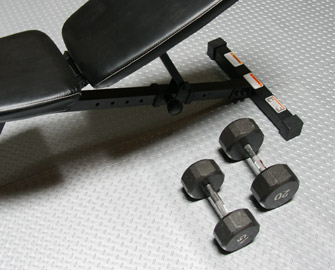|
|
Weight training involves large and heavy weights that can cause serious damage to your home floors which can be costly to repair. Rubber weightlifting flooring offers durable and reliable surface protection against constant and heavy impacts. Thick gym mats offer a sufficient barrier between weight training workouts and your home floor. Rubber workout flooring is a cost-effective option as it prevents costly damage from occurring to your home floors while also being durable enough to resist damage and frequent replacements. Rubber is a shock absorbent material that will prevent damaging energy from reaching the surface of your home floors. In addition, weight room mats are offered in the form of interlocking tiles and flooring rolls, allowing you to find a flooring option that fits the size of the space designated for your home gym. Furthermore, they are available in numerous gauges allowing you to find rubber weightlifting mats that are the correct thickness according to your weight training routine.
What is the Best Floor for Weightlifting?
Rubber weightlifting flooring is the best floor for weightlifting due to its superior shock absorption capabilities and non-slip surface. Due to the wide range of weight training workouts, rubber weightlifting flooring is available in various gauges ranging from 3mm to 1” thick. Rubber is an elastic material that provides cushioning when heavy objects are placed on its surface – it will also return to its original form when pressure is removed. The elastic properties of rubber weightlifting mats allow them to efficiently absorb the force of impact and provide adequate padding to protect sensitive home floors. Case in point, “Due to the elastic properties, rubber store and return most of the input shock or vibrational energy resulting in reduction of the transmissibility” (journals.sagepub.com). Weightlifting is an intensive work out that involves the use of large and heavy weights. Deadlifting and powerlifting can severely damage floors as they are hundreds of pounds of weights being dropped directly onto the floor. Even hard floors, such as concrete, can be damaged by weightlifting equipment. Thick gym mats are ideal for creating a cushioned and shock absorbent barrier between an impact and the subfloor. In addition, rubber weightlifting flooring can offer excellent traction to promote non-slip safety. Weight training requires reliable traction to keep feet firmly planted not only for an effective workout, but also for safety. Rubber is a naturally moisture resistant material that can retain its grippy surface even when moisture is present. Oftentimes, rubber weight room mats are available with an added surface texture or pattern that act as extra gripping points to further enhance rubber’s natural grip.

|

|
-
(a) Are Rubber Floors Expensive?
Rubber floors are cost-effective flooring options that will last for years in abrasive settings. The cost of rubber weightlifting flooring can vary depending on the form, gauge, and quantity. There are two forms of rubber workout flooring: interlocking tiles and flooring rolls. Per tile, interlocking tiles can cost anywhere between $16 and $56 depending on its thickness and material. On the other hand, rubber flooring rolls cost anywhere between $33 and $84 depending on length, gauge, and material. Because weightlifting flooring can be customizable by adding or removing mats, the overall cost depends on the size of the floor. Due to modular flooring’s adhesive-free interlocking mechanism, upon damage, it is easy to remove and replace a single tile rather than the entire floor. Furthermore, the temporary double-sided tape installation of rubber flooring rolls is easy to remove in case of damage. Home floors are nice and can be costly and can be even more expensive to repair if damaged. Common home flooring options, such as ceramic tile, can cost anywhere between $257 and $740 and others, like hardwood, can cost even more between $441 and $1,457 (homeadvisor.com). Rubber weightlifting mats are long-lasting and durable materials that will provide adequate surface protection that will cut costs in repairing expensive home floors.

|

|
(b) What Materials are Gym Floors Made Of?
Gym floors are made of tire derived and synthetic rubber materials. Recycled and reclaimed rubbers are the two tire derived rubbers and are highly durable materials that stand up well against heavy impacts, constant vibrations, and abrasions. Vehicle tires are durable and designed to withstand rough terrain, meaning recycled and reclaimed rubber floors will exhibit the same resilience seen in vehicle tires. Contrastingly, synthetic SBR and thermoplastic rubbers are made through a blend of chemicals that give them enhanced strength. SBR, or styrene-butadiene rubber, is known for its excellent abrasion resistance that makes it a commonly used synthetic rubber in the composition of vehicle tires. Abrasion resistance is a highly beneficial property to have in rubber weight room mats as they will experience constant abuse of heavy impacts. Additionally, thermoplastic rubber is made with a blend of synthetic rubber and plastic materials and offers excellent physical strength and flexibility. Rubber weightlifting flooring will be a durable and long-lasting gym floor option.
Rubber weightlifting flooring offers durable and reliable surface protection and a grippy, non-slip workout floor. Rubber weight room mats are made of either tire derived recycled and reclaimed rubber or synthetic SBR and thermoplastic rubber giving them excellent durability in abrasive setting, such as home gyms. Thick gym mats made of rubber will absorb the force of impact and protect your home floors from damage while also offering a grippy surface that will promote non-slip safety while working out. By protecting your home floors, rubber workout flooring is a cost-effective flooring option that will save in costly home floor repairs. It is also a durable and long-lasting material that rarely require repairs or replacements. Overall, rubber weightlifting flooring are the best floor for weightlifting as it will offer reliable surface protection as well as promote non-slip safety.
What is the Best Floor for Weightlifting?
|
|
|